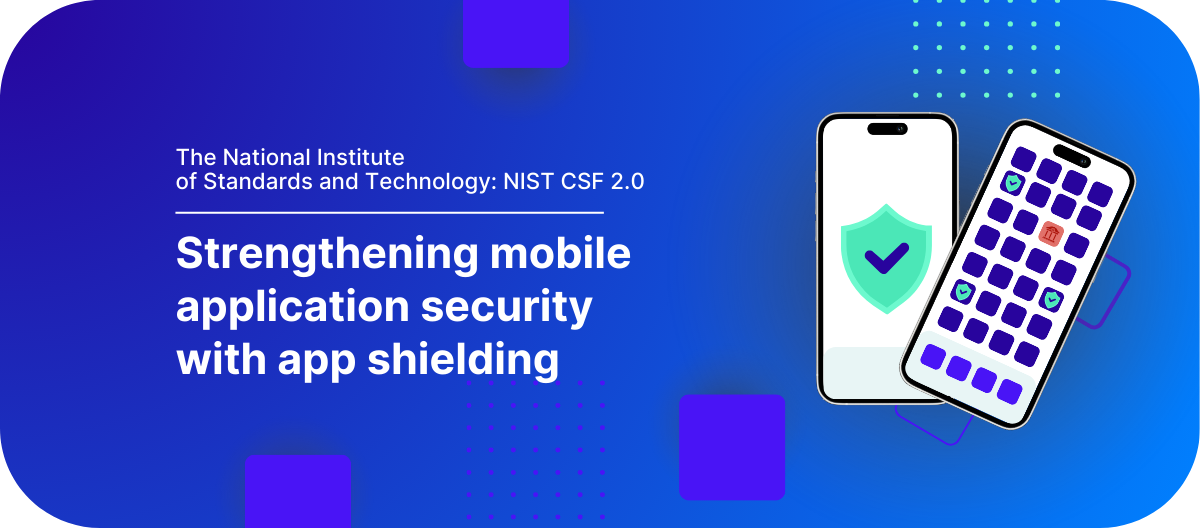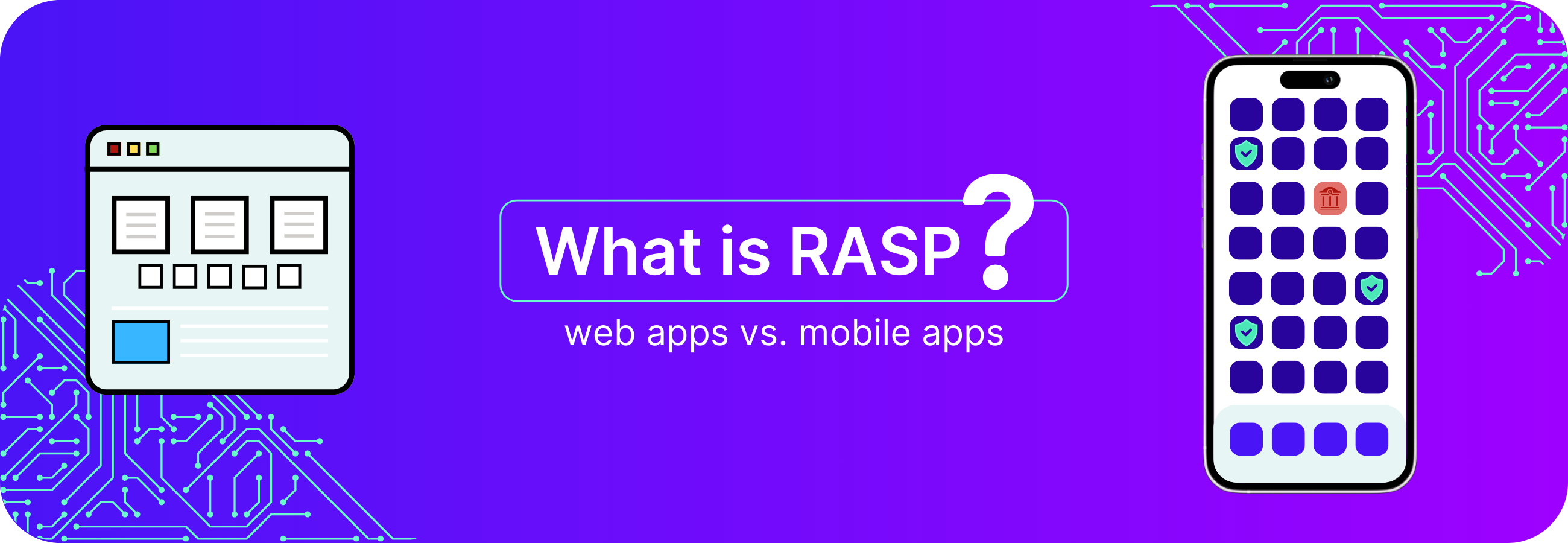How the NIST Cybersecurity Framework 2.0 and app shielding techniques can help you build more secure and resilient apps against evolving threats.
The National Institute of Standards and Technology (NIST) has released an updated version of its Cybersecurity Framework, known as NIST CSF 2.0. This framework provides a comprehensive guide for organizations to manage and reduce cybersecurity risks effectively. As mobile attacks continue to increase in complexity and frequency, the importance of robust mobile application security has never been more apparent.
In this article, we will explore the key changes introduced in NIST 2.0, its impact on mobile application security, and how app shielding techniques align with the framework to provide enhanced protection for mobile apps.
Want to ensure your mobile apps are secure against the latest threats? Download our free checklist to learn how app shielding can protect your apps from the OWASP Mobile Top 10 risks.
The evolution of the NIST cybersecurity framework
The NIST Cybersecurity Framework (CSF) has been a vital tool to help organizations manage and reduce cybersecurity risks since its initial release in 2014. While the framework has undergone minor updates, the release of NIST 2.0 marks a significant milestone in its evolution, with the addition of the new "Govern" function to the existing five functions: Identify, Protect, Detect, Respond, and Recover.
The Govern function emphasizes the importance of establishing and communicating cybersecurity risk management strategies, expectations, and policies throughout an organization. This ensures cybersecurity is treated as a strategic priority and integrated into the organization's overall risk management process.
Other key changes in NIST 2.0 include an expanded scope, clearer language, and a focus on emerging threats. The framework now applies to organizations of all sizes and industries, not just critical infrastructure. It has also been updated to use more straightforward, non-technical language, making it easier for stakeholders at all levels to understand and communicate cybersecurity concepts.
The role of app shielding in NIST 2.0
App shielding — a set of techniques used to protect mobile apps from various threats such as reverse engineering, tampering, and malware injection — aligns closely with the core functions of NIST 2.0. It directly contributes to the Protect function by implementing runtime protection, anti-tampering measures, and code obfuscation to safeguard mobile apps from attacks. Additionally, app shielding protects against repackaging, code injection, hooking frameworks, emulators, rooting/jailbreak attempts, and debuggers.
By monitoring runtime behavior and identifying anomalies, app shielding helps detect potential threats, aligning with the Detect function. Early threat detection enabled by app shielding facilitates faster response and mitigation, supporting the Respond function. In the event of a successful attack, app shielding helps limit the damage and aids in recovery efforts, aligning with the Recover function.
Why is NIST 2.0 important?
NIST 2.0 offers several key benefits for mobile app developers looking to build more secure and resilient apps:
- Comprehensive framework: NIST 2.0 provides a framework for managing cybersecurity risks, covering all aspects of the mobile app development lifecycle. By aligning with NIST 2.0, developers can ensure that they are addressing the most critical security considerations and implementing best practices.
- Emphasis on governance: The new Govern function stresses the importance of establishing and communicating cybersecurity risk management strategies, expectations, and policies throughout the organization. This helps developers secure the necessary resources and support for implementing effective mobile app security measures.
- Proactive approach: It encourages a proactive approach to mobile app security, emphasizing the importance of identifying and mitigating risks early in the development process. This helps developers build security into their apps from the ground up, reducing the likelihood of vulnerabilities and security incidents.
- Supply chain security: NIST 2.0 addresses the growing concern of supply chain security, providing guidance on assessing and managing risks associated with third-party components and services used in mobile app development. By following NIST 2.0 guidelines, developers can ensure the security and integrity of their entire mobile app ecosystem.
- Continuous improvement: NIST 2.0 promotes a culture of continuous improvement, encouraging organizations to regularly assess and update their cybersecurity practices in light of evolving threats and changing business needs. This helps mobile app developers stay ahead of the curve and maintain the highest levels of security and resilience.
Implementing NIST 2.0 and app shielding: Best practices
Understanding the core functions
To effectively integrate NIST 2.0 and app shielding into the mobile app development process, it’s important to understand how the framework's six core functions apply to the specific challenges of mobile app security:
Identify
The Identify function is the foundation of a strong mobile app security strategy. It involves conducting a comprehensive risk assessment to identify potential threats and vulnerabilities specific to your mobile app. This process should include analyzing the app's architecture, data flows, and integration points with third-party services. By thoroughly understanding the app's attack surface, developers can prioritize security efforts and allocate resources effectively.
To put this into practice:
- Create a detailed inventory of all app components, including libraries, frameworks, and APIs.
- Assess the security posture of third-party components and services used in your app development process.
- Identify sensitive data processed by the app and map out its flow through the system.
- Conduct threat modeling exercises to identify potential attack vectors and prioritize risks.
Protect
The Protect function focuses on implementing security measures to prevent attacks and mitigate risks. In the context of mobile app security, this involves applying app shielding techniques such as runtime protection, anti-tampering measures, and code obfuscation. These techniques harden the app against reverse engineering, tampering, and malware injection, making it more difficult for attackers to exploit vulnerabilities.
Integrating advanced app shielding solutions such as Promon SHIELD™ into the Protect function can provide comprehensive protection against a wide range of mobile threats. These solutions often offer multiple layers of defense, including protection at rest. This means that the app is secured against threats even when it is not actively running, such as attempts to repackage the app, perform app binding, or conduct reverse engineering.
Detect
The Detect function is critical for identifying attacks in progress and responding quickly to minimize damage. In mobile app security, this involves monitoring the app's runtime behavior and identifying anomalies that may indicate an attack.
Advanced app shielding solutions often include sophisticated threat detection capabilities, allowing developers to continuously monitor their apps for potential security issues at runtime. These solutions can detect various threats, such as code injection attempts, the presence of hooking frameworks, the use of emulators or debuggers, and even rooting or jailbreaking of the device. By providing real-time visibility into the app's execution, these tools help developers implement effective detection mechanisms and respond promptly to any identified threats.

Respond
The Respond function focuses on taking action to contain and mitigate the impact of a security incident. In the context of mobile app security, this involves having a well-defined incident response plan that outlines the steps to be taken in the event of an attack.
To improve your incident response capabilities:
- Develop a detailed incident response plan that includes clear roles and responsibilities for all stakeholders.
- Establish procedures for containing the impact of an attack, such as revoking access tokens or shutting down compromised components.
- Use app shielding solutions to gather detailed forensic information about the attack, including the attacker's tactics, techniques, and procedures.
- Conduct regular incident response drills to test the effectiveness of the plan and identify areas for improvement.
Recover
The Recover function focuses on restoring normal operations after a security incident has been contained. In mobile app security, this involves ensuring that the app's data and functionality are restored to a known-good state. App shielding solutions can help developers recover more quickly from incidents by providing secure backup and recovery mechanisms.
To ensure a smooth recovery process:
- Implement secure backup and recovery mechanisms to ensure that the app's data can be restored quickly and safely after an incident.
- Use app shielding solutions to verify the integrity of restored data and ensure that it has not been tampered with.
- Conduct post-incident reviews to identify the root cause of the incident and implement measures to prevent similar incidents in the future.
- Communicate transparently with users about the incident and the steps taken to recover from it.
Govern
The new Govern function in NIST 2.0 emphasizes the importance of establishing and maintaining a strong cybersecurity governance framework. In the context of mobile app security, this involves defining clear policies, procedures, and accountability mechanisms for ensuring that security is integrated throughout the app development lifecycle. App shielding solutions can help developers implement effective governance mechanisms by providing visibility into the app's security posture and compliance with relevant standards and regulations.
To establish a robust governance framework:
- Define clear roles and responsibilities for all stakeholders involved in the app development process, including developers, security teams, and business owners.
- Establish policies and procedures for secure coding, testing, and deployment of mobile apps.
- Implement metrics and reporting mechanisms to track the app's security posture and compliance with relevant standards and regulations.
- Conduct regular security audits and assessments to identify areas for improvement and ensure that governance mechanisms are effective.
Integrating NIST 2.0 into the development lifecycle
Incorporating NIST 2.0 principles into the mobile app development process is essential for ensuring a secure and resilient app. CSF 2.0 offers practical implementation examples that can be seamlessly integrated into your development lifecycle. Consider the following guidance:
- Planning: Define clear cybersecurity goals and objectives aligned with the organization's risk management strategy. Identify potential threats and vulnerabilities specific to your mobile app.
- Design: Incorporate security best practices into the app's architecture and design, considering the unique challenges of the mobile environment, such as data protection, secure communication, and access control.
- Coding: Implement secure coding practices, perform regular code reviews to identify and address potential vulnerabilities, and integrate app shielding techniques.
- Testing: Conduct thorough security testing, including penetration testing and runtime behavior analysis, to validate the effectiveness of the implemented security controls. Use app shielding tools to monitor and detect anomalies during testing.
- Deployment: Ensure that the app is securely deployed and configured, with appropriate access controls and encryption mechanisms in place. Continuously monitor the app's runtime behavior using app shielding techniques to detect and respond to potential threats.

A step-by-step guide to implementing app shielding
Implementing app shielding in alignment with NIST 2.0 involves the following steps:
- Risk assessment: Begin by conducting a comprehensive risk assessment to identify the specific threats and vulnerabilities your mobile app faces, aligning with the "Identify" function of NIST 2.0.
- Tool selection: Choose app shielding tools that seamlessly integrate with your development environment and provide the necessary protections for your app. Consider factors such as ease of use, compatibility, and specific security features offered.
- Implementation: Integrate the selected app shielding tools into your development process, following best practices for runtime protection, anti-tampering, and code obfuscation, ensuring alignment with the "Protect" function of NIST 2.0. It's worth noting that some app shielding solutions are post-compile and do not interfere with any development activities, making the implementation process even more streamlined.
- Testing and monitoring: Continuously test your app's security measures and monitor for potential threats, aligning with the "Detect" and "Respond" functions of NIST 2.0. This ensures that your app remains protected as the threat landscape evolves.

Choosing the right app shielding solution
When selecting an app shielding solution to align with NIST 2.0 principles, there are several key factors to consider. First and foremost, the solution should provide comprehensive protection against a wide range of mobile threats. It should also offer multiple layers of defense, such as code obfuscation, encryption, anti-tampering measures, and runtime protection, to ensure that apps are resilient against even the most sophisticated attacks.
Another important factor to consider is the ease of integration. The app shielding solution should seamlessly integrate with your existing development tools and processes, minimizing disruption and enabling efficient implementation. It should also be compatible with the languages and frameworks you use, ensuring that it can be easily incorporated into your app development lifecycle.
Scalability and performance are also critical considerations. The app shielding solution should be able to scale with your app's growth and user base, without compromising performance or user experience. It should have minimal impact on app startup times, memory usage, and battery consumption, ensuring that your app remains responsive and user-friendly.
When evaluating app shielding solutions, it's also essential to consider the level of support and expertise provided by the vendor. Look for a solution that offers detailed documentation, training, and technical support to help you get the most out of the product. The vendor should have a proven track record of success in the mobile app security space and be committed to staying ahead of the latest threats.
The future of NIST 2.0 and app shielding
One of the key trends shaping the future of mobile app security is the increasing sophistication of attacks. Attackers are constantly developing new techniques and exploiting vulnerabilities in mobile platforms and apps, making it essential for app shielding solutions to stay up-to-date with the latest threats and vulnerabilities. These solutions should provide robust protection against data breaches and unauthorized access. This includes encrypting sensitive data at rest and in transit, as well as implementing secure authentication and access control mechanisms.
In addition to the NIST Cybersecurity Framework, organizations should also consider the guidance provided in NIST Special Publication 800-163 Revision 1, titled 'Vetting the Security of Mobile Applications.' This publication offers a comprehensive approach to assessing the security of mobile apps, including evaluating app permissions, testing for vulnerabilities, and analyzing privacy implications.
By leveraging the app vetting process outlined in NIST SP 800-163, organizations can ensure that the mobile apps they develop or adopt meet stringent security and privacy requirements. This is particularly important in the context of enterprise mobility management and BYOD (Bring Your Own Device) policies, where personal devices are used to access sensitive corporate data.
To stay ahead of the curve and ensure mobile app security in the NIST 2.0 era, app developers should:
- Stay informed about the latest app threats and vulnerabilities.
- Implement a comprehensive mobile app security strategy that aligns with NIST 2.0 principles.
- Choose an app shielding solution that provides comprehensive protection against a wide range of mobile threats, while also being easy to integrate and maintain.
- Regularly test and validate the effectiveness of your app shielding measures.
- Foster a culture of security within your organization.
By following these recommendations and staying vigilant in the face of emerging threats, app developers can ensure that their apps remain secure and resilient in the NIST 2.0 era.
Is your mobile app vulnerable to security flaws and attacks? Our comprehensive checklist, based on the OWASP Mobile Top 10, shows you how app shielding can mitigate the most common threats.




